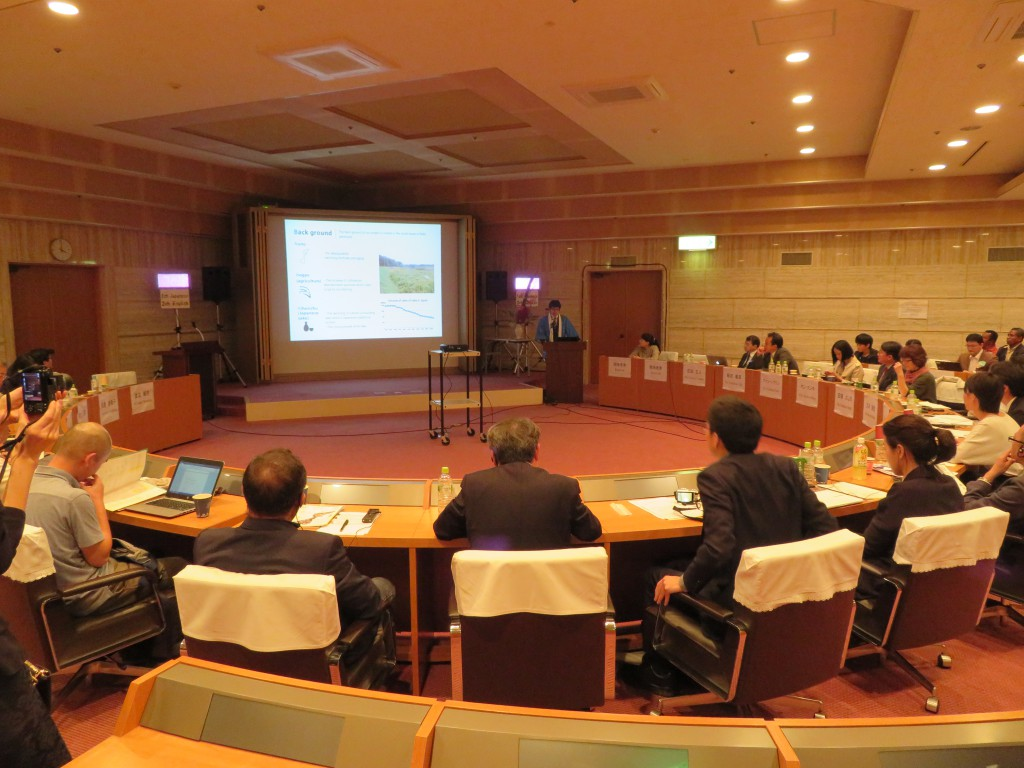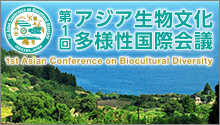International forum series 2: Preserving biocultural diversity for future generations: partnership of East Asian countries
15 October, 2017, Kanazawa
This forum was co-hosted with Japan committee for IUCN. Together with IUCN committee members and youth participants from Japan, China, and Korea, how to conserve biocultural diversity for future generations was considered.
In the keynote speech, Masahito Yoshida (Professor of University of Tsukuba) gave a lecture on the linkage between nature and culture, including international systems.
At section 1, cases on biocultural diversity in Japan, China, and Korea were introduced. Yoshihiko Iida (OUIK Research Associate) described some activities related to biocultural diversity in Ishikawa and related issues. He pointed out the importance of “diversity” approach to achieve conservation of biocultural diversity through regional initiatives. Xiuling Guan (Director of International Department of Chinese Society of Forestry) presented a case on oak forest management in China and Sun-Kee Hong (Professor of Institution for Marine & Island Cultures, Mokpo National University) advocated the need for a global initiative on island biocultural diversity to achieve sustainable development. Yoshino Ando (Joint Representative of Ramsar Network Japan) introduced their activity to improve biodiversity in rice paddies (Rice-paddy Biodiversity Enhancement Decade).
At Q&A session of section 1, various questions were asked from the audience on topics such as: forest management and conservation method; use of U-shaped gutter or herbicide and biodiversity conservation in rice paddies; building “links” between individual learning; co-existence of nature and livelihood; biocultural diversity and regional revitalization; and issues on legal systems. Participants from Japan, China, and Korea discussed these topics from various viewpoints.
At Q&A session of section 2, youth participants discussed how to make primary industry attractive to young people. Participants pointed out the need for a system which guarantees adequate payment and improving social status. Another participant mentioned the importance for consumers to buy the products considering producing areas and production method. It was also discussed how we could expand our activities to develop links between young people to pass on our nature and culture to future generations.
At the end, Ambassador Masahiko Horie (IUCN Councillor, Special Assistant to the Minister for Foreign Affairs) closed the forum by mentioning the importance of expanding the already existing valuable activities of young people, raising awareness of and mainstreaming biocultural diversity, and building up cohesion and cooperation among global communities.
Field Excursion
Thirty-one participants from Japan, China, and Korea attended the field excursion which was held prior to the forum.
Participants visited Team Maruyama in Wajima and learnt about their activities from the team organizers: Kiichiro Hagino (an architect), and Yuki Hagino (a designer); as well as Koji Ito from Kanazawa University who supports their activity. They outlined their efforts to protect the connection between local tradition, culture, and biodiversity and pass them on to future generations.
Kiichiro Hagino described the reasons why they had moved to Noto and outlined their activities. Yuki Hagino explained how they had arranged the local traditional ritual, Aenokoto, into an original ritual to appreciate biodiversity and how they had been carrying out the ritual every year with a wide variety of participants. She also introduced her original booklets and educational materials such as a seasonal calendar which contains information related to local wisdom, culture, and biodiversity. Koji Ito introduced Satoyama Satoumi Meister Training Program of Kanazawa University which had given the opportunity to start Team Maruyama’s activity, and also about plant monitoring activity which had been carried out by Team Maruyama every month.
Participants were impressed by their inventive programs and educational materials to deliver their messages to general public and children. Participants asked questions enthusiastically, holding and seeing the details of her handmade puppets and booklets. After the visit, some of the participants expressed their interest in starting similar activities in their own countries.
After that, they visited Shiroyone Senmaida (AThousand Rice Paddies) and learnt why these terraced rice paddies had been created in this place and also about the ownership system to protect the landscape of these rice paddies. Participants had a stroll around the Senmaida and fully enjoyed the beautiful landscape of the terraced rice paddies at the seaside.




